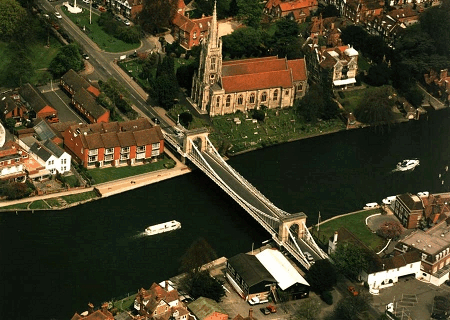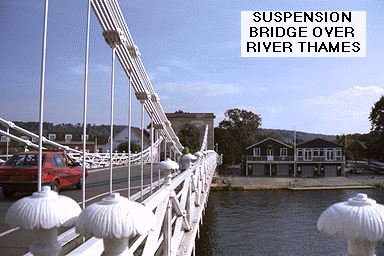Marlow Suspension Bridge
There has been a bridge across the Thames at Marlow since before 1227. The present bridge was built between 1829 and 1832 to replace the wooden bridge sited further downstream, which had grown inadequate for the growing traffic on the Reading and Hatfield Turnpike road. It eventually collapsed in 1828. William Tierney Clark FRS MICE (1783-1852) was appointed to design a new bridge and supervise its construction. In the Marlow Bridge Act of 1829 the responsibility for the upkeep of the bridge was transferred from the Office of Bridgewarden to the Counties of Buckinghamshire and Berkshire in the ratio of 4:1. In the 1950s it was proposed to replace the Suspension Bridge with a ferro-concrete span, and The Marlow Bridge Preservation Committee (from which The Marlow Society arose) was formed to oppose this plan. In 1965 the Suspension Bridge was faithfully reconstructed by Buckinghamshire County Council. The main span is 235 feet long. In order to preserve the bridge the weight restriction has been changed from five tonnes to just 3 tonnes, which effectively bans lorries and vans from crossing the bridge.
Tierney Clark was born in Bristol. He was apprenticed as a millwright and later worked under two great civil engineers, Thomas Telford and John Rennie. He became a Fellow of The Royal Society and a Member of the Institution of Civil Engineers. Links With The Széchenyi Chain Bridge, BudapestTierney Clark designed four suspension bridges: at Hammersmith, Shoreham, Marlow and, the largest, at Budapest. Only the Marlow and Budapest bridges survive. The Budapest bridge is known as the Schenyi Chain Bridge and is named after Count Istvn Szchenyi who, in 1839, invited Tierney Clark to design and build a bridge across the Danube. It was the first permanent bridge across the Danube below Vienna since Roman times. Destroyed in World War II, it has since been faithfully reconstructed. The main span is 666 feet long; for a time the longest in the world. A plaque (unveiled in May 1998) on the chenyi Chain Bridge commemorates the link with Marlow Suspension Bridge. New Commemorative Plaques on Marlow BridgeTwo identical new plaques, designed and carved in grey-green Lakeland slate by Martin Cook of Loudwater, have been erected on the triumphal arches to commemorate
Part of the English inscription is repeated in Hungarian. These plaques were unveiled by the Hungarian Ambassador, Tade Alfoldy, at a special ceremony on 26 September 1996. |
|||||||

